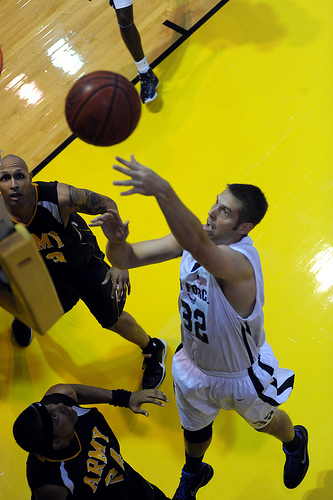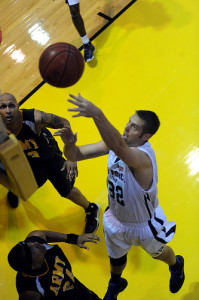How to Teach a Hook Shot

The Hook Shot is a very beneficial skill for interior players to acquire. The Hook Shot provides a Technique that is effective in scoring while also being difficult to defend against if performed correctly. This is especially valuable for those players who find themselves undersized in and around the keyway. The Hook Shot can be used from in the keyway, but as the individual becomes more and more confident as well as competent, this range can be extended to around the perimeter of keyway itself.
The Hook shot is a challenging skill for new users, as it must have each individual step performed well at the risk of losing the techniques effectiveness completely.

Initially start a player side on, rather than back to the basket; if you draw a line through both shoulders this should point directly to the middle of the hoop. Less movement from the side on position will help simplify the technique
Player’s feet should be slight wider then shoulder width apart; this will help with balance once linked to initial back to the basket moves, help create stability so the player cannot be pushed out of position and help with elevation in the jump
Player should start in a squatting position, knees bent to ninety degrees, back straight and shoulders back; this will help with balance and jumping
A player should turn their head over the interior shoulder to see the basket at all times; once side on to the basket the post player must turn their head to see both the defender and basket
Ball should be held with both hands on the hip furthest away from the basket; this helps create three points of contact (two hands and hip) which will improve control. This position also ensures the ball is also at the furthest point away from the defender. Additionally, the shoulder closest to the basket because of the arm stretched across the body to the opposite hip will dip slightly making for a more effective bumping position as it is braced against the torso.
Hip, Shoulder, Ear and Extended; the line that the ball should travel will be that of straight up the furthest side of the body. Using two hands the ball will start on the hip, maintaining two handed contact the ball is raided to the shoulder. The ball is then raised further with the two hands to the height of the ear, before being released by the interior hand and the outside arm now fully extending with the hand flicking the ball up and over, down into the basket.
Jump; as the ball reaches the ear position, the offensive player must now jump harnessing that coiled strength and power through their legs to help elevate themselves up and over a defender. This helps in making the Hook Shot that much harder to block
Hand to Elbow; Once the inside hand releases from the arm closest to the basket, it then fills the role of shielding the ball from the defender. This arm cannot be extended outside of a players cylinder or used as an offensive push, it can be used to interfere with the defenders attempt to block or disrupt the Hook Shot. The interior arm should be continued to remain at the high a little above the head (with the hand in line with the elbow of the outside arm once fully extended). This will ensure the defender cannot jump across the offensive player if performed correctly. So the arm must be kept strong and not allowed to be dropped or pushed out of position by a would be defender.
Rotation: As the two hands separate off the ball and the interior arm moves into a shielding role, the hips of the offensive player be slight rotated towards the basket. This has a number of benefits. Firstly is allows for more control by the offensive player in pushing the ball towards the basket. Secondly, this movement will allow the interior shoulder to be wedged into the torso of the defender effectively pinning the player away from the ball. The rotation should only be a few degrees and should not result in the post player landing and now facing the basket with their chest completely front on the hoop
Trouble Shooting
Players performing a Hook Shot must maintain a lower centre of gravity at all times until the jump. It is not uncommon for players to bounce during the reception and footwork in the lead-up to the Hook Shot. This causes players to raise their stance and can result in a weakness being created that could mean a player is more easily pushed out of form or away from the intended shooting area.
An explosive effort must be applied to the footwork and lead-up to the jump off for the Hook Shot. Too often, the drop step that leads to the jump-stop of the Hook Shot is performed slowly and awkwardly. Once the movement is initiated for the start of the movement into the desired position for the Hook Shot, the post player must remain strong and compact so they can generate maximum exploitive effort for the jump following the jump stop.
If catching and looking to pivot into the Hook Shot, the discipline to maintain a low, wide stance also serves to help create elevation as this is the harder of movements from which to create a good scoring position.
The Hook Shot looks to create a good shooting position not by speed or athletic ability alone. The technique focuses on creating advantage out of limited space in situations that are often high-pressure scenarios. To be effective a player must be able to perform all the technical steps of a Hook Shot while still having pressure maintained by the defence. Close defensive pressure once the fundamental technique is mastered will help the offensive player refine their skill and perform the Hook Shot better than if they only practice in 1 v 0 situations.
The Hook Shot is a vital skill for interior or post players to have within their skills set. It should be remembered though, that the skill is advanced in nature and is best left to those players who have developed good special awareness, strength in body positioning and footwork around the keyway. The introduction of the Hook Shot too early can slow down a post players development with relation to other skills needed to play the position.





